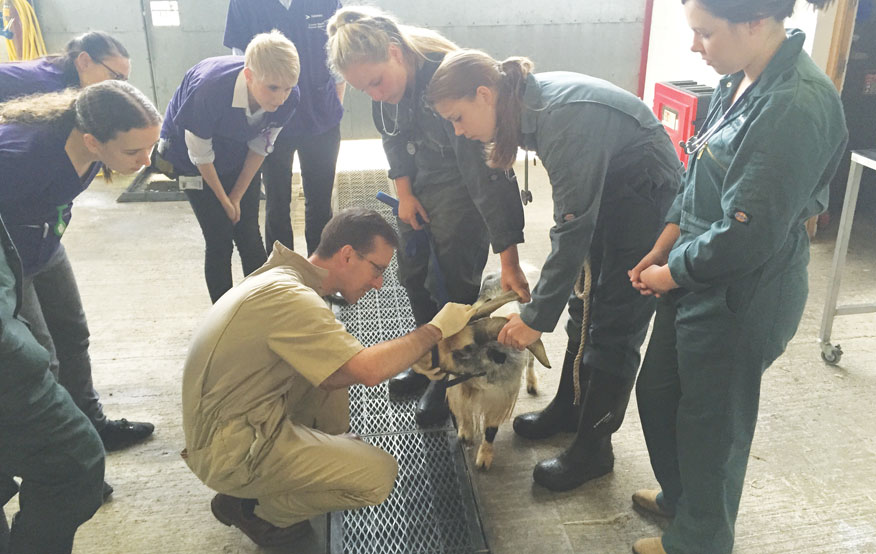Listeriosis Goat
Clinical Connections – Spring 2017
A four-year-old male pygmy goat (Danny) was admitted after five days history of being depressed. He was treated for an upper respiratory tract infection by the referring vet but developed multiple cranial nerve deficits and became anorexic. There was no history of head trauma. The herd was CAE accreditation negative. Danny weighed 29kg on admission.
Case Insights:
The head tilted to the right, Danny was unable to eat and he salivated from the right side of his mouth. There was facial asymmetry and no jaw tone. The right side of the face had no sensation, no palpebral menace or response. There was a ventromedial strabismus of the right eye with no pupillary light reflex and a reduced consensual pupillary light reflex.
These responses were positive on the left hand side apart from an absent consensual pupillary light reflex. On manipulation of the tongue, Danny was able to withdraw it and there was no deviation. Danny reluctantly walked in a clockwise circle and navigated an obstacle course, indicating no blindness.
This was primarily a neurological disease of the right side of the brain with the depression and anorexia secondary to this. The most common differential for these clinical signs are listeriosis, brain abscess, otitis media or otitis interna, coenurosis (gid), migration of nasal bot (oestrus ovis) and trauma. Metabolic disease and potential toxicities were further down our differential list due to the unilateral nature of disease. Clinical signs were not consistent with botulism or tetanus.
A CSF sample analysis was consistent with listeriosis, despite no bacteria being seen. High dose penicillin is the recommended treatment for listeriosis. Marbofloxacin was given to provide a broad spectrum antibiosis as we had concerns about inhalation pneumonia becoming a potential complication. Meloxicam was given for analgesia and dexamethasone administered for anti-inflammatory purposes. Vitamin B1 was given to prevent potential cerebrocortical necrosis.
When presented with a ruminant with unilateral neurological deficits, listeriosis is the primary differential. Definitive diagnosis can only be confirmed at post mortem so diagnosis is made by observing the clinical signs, response to treatment, and by ruling out other differentials.
Listeria is a gram-positive bacteria normally associated with poorly fermented silage, can remain in the environment for several months. Some animals carry the bacteria asymptomatically. Other clinical diseases caused by listeriosis include abortion, septicaemia and keratoconjunctivitis. The neurological form of the disease often presents in only one or two animals, rather than a herd outbreak. It is assumed that the bacteria enters the brain due to a traumatic lesion in the mouth which breaks the mucosa and allows the bacteria to track up the trigeminal nerve.
Although cows commonly present as going around in circles, small ruminants such as goats tend to present as depressed initially, with a head tilt being the first unilateral deficit noted.
Owners Advice:
They were advised to check the quality of the roughage and not feed any spoiled foodstuff to the goats. The owners were warned that the pathogen can live in the environment for several months and so to remain vigilant for clinical signs.
Danny the goat:
Recovery Diary
Day 2
- Little change in Danny’s presentation and the CT scan showed no evidence of middle ear infection and trauma
- Lost teeth (allowing listeria to enter the brain)
- Obvious space occupying lesions
- Listeria remained our likely differential
Day 3
- Increased responsiveness
- Sodium bicarbonate fluid supplement given intravenously to address rumen and blood acidity caused by lack of ingestion of saliva
- Orogastric tube was passed and magnesium hydroxide given to increase the rumen pH.
- Some clinical improvement and responsive to stimulation
- Roughage consumption began
Day 7-8
- Head tilt resolved
- Eyelid, ear and eyeball were in a normal position
Day 9-13
- Gradual medication withdrawal
Day 14
- Discharged (weight 22kg)
Day 28
- Re-assessment of the eye - now able to move the eyelid to cover half of the eye
- Weight 25kg and behaviour normal

